
|
|
|
|
 |
|
Home Site Search Contact Us Subscribe
|
|
|
|
INSIGHT: Chihuly Bridge of Glass By Arthur W. Andersson, AIA/Andersson-Wise Architects
Tacoma, Washington: An architect and an artist combine visions for a pedestrian crossing. by Arthur W. Andersson, AIA October 3, 2002 "This will be the
gateway that welcomes people to Tacoma. We wanted something unique in the
world, something that has a lot of color, a joyous experience, night or
day." — Dale Chihuly A successful collaboration
with renowned artist Dale Chihuly gave rise to the Bridge of Glass. Through the
synthesis of art and architecture, Andersson-Wise Architects and Chihuly sought
to create an enduring and experiential public landmark for the City of Tacoma.
We worked together, evolving this unique concept, over the past eight
years. Dale and I
studied the great bridges of the world. We discovered they all had one thing in
common: they all spanned a river, gorge, or some other natural obstacle. Our
context is different: our river is a river of cars and trains; our gorge is a
gorge of concrete and metal. The bridge, which opened July
6, provides a crucial pedestrian connection linking Tacoma’s new Museum of Glass and surrounding
waterfront More than a way to move from
point A to point B, the Bridge of Glass is an
The bridge grows from its
material context of concrete and steel. Massive concrete supports and the
painted steel superstructure have a powerful yet neutral presence that stands
in contrast to Chihuly’s artwork. The idea was not to compete for attention but
to create a prosaic counterpoint to the poetry of glass. Chihuly designed the Crystal
Towers to soar nearly 40 feet above the bridge’s center section, forming both a
grand urban gesture and a new landmark for Tacoma. As the towers flank the
inbound side of the freeway, they serve as a visual gateway to downtown. The
sculptures rest on steel pedestals atop the bridge’s centermost piers. Their
placement makes them more stable. Two semi-enclosed pavilions
– the Seaform Pavilion, on the east side of the bridge, and the Venetian Wall
to the west – were created as experiential installations of Chihuly’s art.
Their design provides a minimal frame The rhythm of the bridge
structure provided an opportunity for syncopation of the pavilions. Two
concrete piers border the Venetian Wall, forming edges for its orderly grid. A
single pier bisects the Seaform Pavilion, allowing the undulating installation,
with its implication of infinity, to float in both directions. I
worked with Chihuly and A. Zahner Company, a noted Kansas City architectural
metal company, to define an architectural palette that would best compliment
the art. Zahner’s team fabricated the pavilions from blackened stainless steel,
which has a satin finish that is both neutral and non-reflective . Tinted, translucent glass
panels illuminate the southern and northern sides of the pavilions, allowing
viewers to immerse themselves in the experience without distraction. The project was funded
through a combination of federal, local, and private funds. Construction began
in spring 2001. The bridge structure is 500 feet long by 20 feet wide and rises
35 feet above the road. Tacoma, with its context of old brick manufacturing and
warehouse buildings, is in the midst of a remarkable transition. Recent
developments near the Bridge of Glass and those now underway include: - Museum of Glass:
International Center for Contemporary Art: Opened July 6, 2002, the museum and
glass hot shop were designed by Arthur
Erickson Architects of Vancouver, BC. - Renovation of 1911 Union Station
and expansion of the Federal Courthouse: The Tacoma firm of Merritt+ Pardini
rehabilitated this local landmark in 1992.
- Washington State
History Museum: The first new building and a catalyst for the historic
district’s rebirth, the museum was designed by Arthur Andersson and Charles
Moore, and completed in 1996. A pedestrian bridge from the museum site to the
waterfront was part of Moore/Andersson’s competition-winning scheme. - Tacoma Art
Museum: This new museum, designed by Antoine
Predock, is under construction on Pacific Avenue, neighboring the
Washington State History Museum and Union Station. - University of
Washington Tacoma campus: The Tacoma satellite campus, which focuses on
science and technology, is under development on a large site in the hills
behind Pacific Avenue. Moore Ruble
Yudell Architects of Los Angeles designed the master plan. - Thea Foss Waterway mixed-use: A public walkway, cultural
facilities, parks, hotels, offices, shops, and restaurants are under
development on the once-blighted downtown waterfront, adjacent to the new
Museum of Glass. - Greater
Tacoma Convention Center: This $87 million, 230,000-square-foot facility is
scheduled for completion in 2004. The design team includes Merritt+Pardini
Architects; Wyn Bielaska; MulvannyG2
Architecture; Nakano Associates
(landscape); and artists Stuart Keeler and Michael Machnic. Chihuly
Bridge of Glass Project Credits: Owner: City of Tacoma & Museum of Glass Architect: Andersson•Wise Architects Design Team: Arthur Andersson, AIA (Principal-in-Charge),
Chris Wise, AIA (Managing Principal), Adam Pyrek (Team Leader) Glass Artist: Dale Chihuly Consultant Firms: Architectural metal: A.
Zahner Company Structural/Bridge: Andersen, Bjorstad, Kane & Jacobs Structural/Pavilions: Putnam Collins Scott Associates Mechanical Engineering: Energy Engineering Associates Electrical Engineering: Hultz/BHU Consulting Engineers CA Architect: Thomas Cook Reed Reinvald Architects Lighting Design: Horton Lees Brogden Lighting Design;
Pacific Lightworks, LLC Specifications: Eskilsson Architecture Photography: Tim Hursley Construction Cost: $12 Million Gross SF: 10,000 SF Completed: July 2002 Andersson-Wise Architects was founded in 2001 by Arthur W. Andersson and F.
Christian Wise following a 15-year collaboration together and with Charles W. Moore,
first as the Charles Moore Studio and later as Moore/Andersson Architects.
Moore and Andersson began working together in 1981 when they collaborated on
the White River Park Project. Shortly thereafter, they co-designed the
Wonderwall and Centennial Pavilion at the New Orleans World’s Fair. Wise joined
the firm in 1985 as a principal design collaborator for the studio. Moore is
recognized as having been one of this century’s greatest architects - his work,
writing, and teaching have profoundly influenced the course of architecture
worldwide. By practicing and evolving his teachings, the firm has become a
design collaborative of 12 architects and designers, dedicated to excellence in
public, religious, commercial, and residential design. Dale Chihuly lives and works in Seattle, Washington. He was the
first American to work in the Venini factory in Venice, Italy, and in 1969
established the glass program at the Rhode Island School of Design where he
taught full time for 11 years. In 1971, he co-founded the Pilchuck Glass School
in Stanwood, Washington. His well-known series of works include Baskets,
Seaforms, Persians, and Venetians. In 1995 he embarked on the
multifaceted international project, Chihuly Over Venice where
chandeliers, some 20 feet long, were suspended over canals and the piazze of
Venice. In 1999, he mounted Chihuly in the Light of Jerusalem 2000, an
exhibition of large-scale sculptures within the stone walls of an ancient
military fortress, which is now the Tower of David Museum of the History of
Jerusalem. During the summer of 2001, Chihuly hosted a major exhibition at the
famed Victoria and Albert Museum in London, England. His first major glasshouse
exhibition, “Chihuly in the Park: A Garden of Glass” was recently presented at
the Garfield Park Conservatory in Chicago. |
(click on pictures to enlarge) 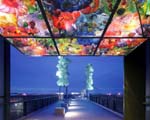 (Tim Hursley) Bridge of Glass: view east from Seaform Pavilion to Crystal Towers at dusk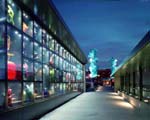 (Tim Hursley) View west from Venetian Pavilion at dusk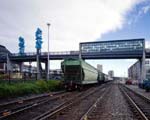 (Tim Hursley) View north from railway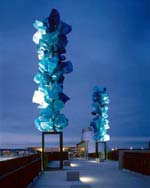 (Tim Hursley) View east to Crystal Towers at night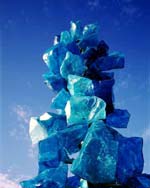 (Tim Hursley) Crystal Tower detail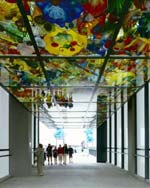 (Tim Hursley) View east from Seaform Pavilion to Crystal Towers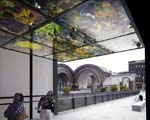 (Tim Hursley) View west from Seaform Pavilion to Washington State History Museum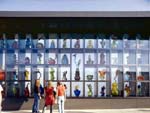 (Tim Hursley) Venetian Pavilion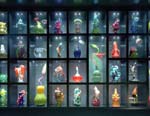 (Tim Hursley) Venetian Pavilion detail at night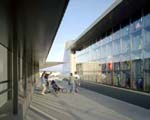 (Tim Hursley) View east from canopy to Venetian Pavilion and the Glass Museum (-) Bridge plan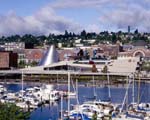 (Tim Hursley) View from the waterfront |
© 2003 ArchNewsNow.com